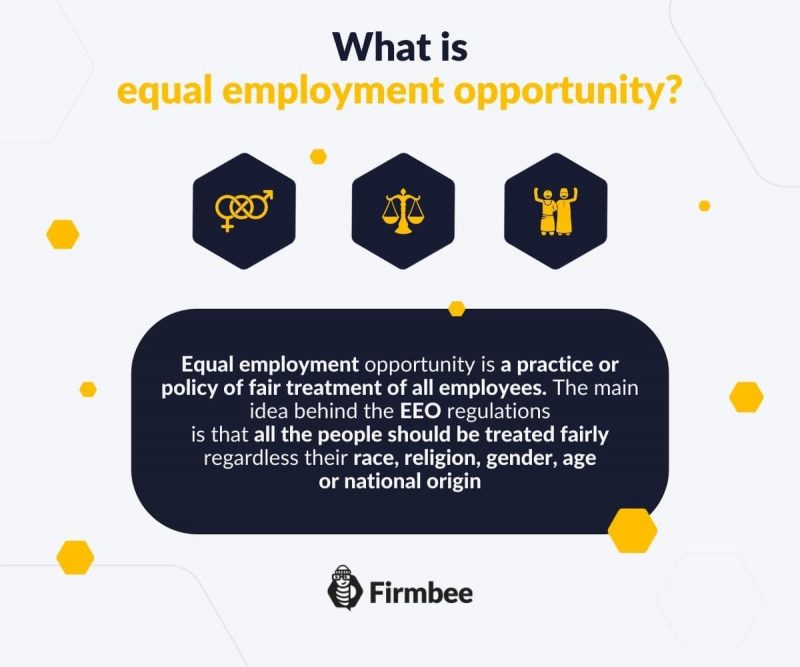Equal employment opportunity is a practice or policy of fair treatment of all employees. The main idea behind the EEO regulations is that all the people should be treated fairly regardless their race, religion, gender age or national origin. Everybody should be able to develop on the basis of the merit and employers should create conditions where all individuals are valued and able to perform to their fullest potential.
Equal employment opportunity and the glass ceiling – table of contents:
- What is equal employment opportunity?
- What is glass ceiling?
- What causes the glass ceiling effect?
- Summary
What is equal employment opportunity?
Equal employment opportunity is a practice or policy of fair treatment of all employees. The main idea behind the EEO regulations is that all the people should be treated fairly regardless their race, religion, gender age or national origin. Everybody should be able to develop on the basis of the merit and employers should create conditions where all individuals are valued and able to perform to their fullest potential.
Currently it is illegal to discriminate against a candidate or employee on the basis of: race, age, gender, religion, disability or national origin and most of the multinational employers as well as European establishments develop their own policies to provide equal opportunities for everybody. It is highly recommended to all employers to have such regulations in place since their implementation becomes a norm of all civilized nations. Among the main activities and processes covered by anti-discrimination laws and policies are: recruitment, hiring, promotion, compensation, benefits, training, harassment, and segregation.

What is glass ceiling?
Women and minorities were typically subjected to adverse treatment. With the EEO policies in place some of the traditional barriers have been eradicated, but there is still a broad space for improvement in this area. The metaphor of “glass ceiling” refers to an invisible barrier some women and representatives of minorities approach at the higher stages of their careers.
The barrier stops women and minorities from getting high-paying, leadership positions regardless of their qualifications and accomplishments, as well as deprive them of equal pay for work of the equal value done by more privileged groups. Equal employment opportunity (EEO) laws view the issue of glass ceiling as a specific case of occupational segregation. Any form of segregation in the workplace is forbidden, but complexity of the factors related to the glass ceiling phenomenon hinders the efforts of legislators.
What causes the glass ceiling effect?
There are several reasons for the glass ceiling effect, not all of them are work related, some are rather connected to the whole culture and advancement of human societies. Among many of the causes for existence of the glass ceiling problem are household duties and childcare all women do. An average woman, who has children is being paid less and she is less likely to be promoted. Women with children are seen as less committed than other members of the society, such as: single women, single men and fathers. The employers are aware that most of the household duties are performed by the women hence they women are perceived as less ambitious and less flexible.
Another problem related to the glass ceiling is the idea of covering, where the employers expect all their employees to be not involved in any form of self-expression, especially when it may influence the workplace. Corporate wold sees workplace as the reality designed for white, tall, single men, and doesn’t take into consideration that most of the workers don’t belong to this group. It is expected that mothers won’t talk about their children, gay people won’t show of their identity, and people of color won’t talk about race issues.
The next very important issue strongly connected to the glass ceiling problem is sexual harassment. After many years of research it is still unresolved and probably there is no good policy to stop it since it is solidly intertwined with cultural values and societal rules. It has been estimated that eight in ten women will experience some forms of sexual harassment at their workplace. Some of them will decide to leave their job, which means that their careers will suffer and their employers will lose their potential.
The next reason of this form of discrimination deals with culture as a whole and the overall perception of femininity and masculinity. Cultural stereotypes and expectations towards women and minorities play important role in the glass ceiling phenomenon. Women are expected behave and speak in polite, respectful way. They should be non-assertive, timid, quiet and submissive. If they show any form of assertiveness they are being labelled, mocked and punished. So called “bossy” women are seen as non-feminine, not attractive, and unpleasant. They have to choose between being effective in their roles of leaders and being accepted and liked as females.
Accordingly to the American Equal Employment Opportunity Commission women represent 48 percent of all employees but only 36.4 percent of managers, and still most of the industries are least likely to employ women as managers. Most of the managerial positions filled with women are in the health care sector. Additionally, white males fill most top managerial positions in corporations and legal industries.
The phenomenon of the glass ceiling is highly detrimental to the whole economy since it means that some of the most qualified employees are unable to move to the positions, where their skills and knowledge could be used. Such criteria as race or gender should be irrelevant when the qualifications and abilities should play the major rule.
Summary
It is illegal to discriminate against an individual on the basis of race and gender and the glass ceiling is a form of hidden discrimination, which needs to be eliminated from our workplaces. The complete eradication of the glass ceiling will requires fierce enforcement of EEO regulations therefore all employers should develop their own EEO policies and to remove all organizational barriers, which stop minorities and women from advancing to higher level positions.
Read also: Hostility in the workplace
If you like our content, join our busy bees community on Facebook, Twitter and Linkedin.
Author: Nicole Mankin
HR manager with an excellent ability to build a positive atmosphere and create a valuable environment for employees. She loves to see the potential of talented people and mobilize them to develop.
The most important questions
-
What is equal employment opportunity?
Equal employment opportunity is a practice or policy of fair treatment of all employees. The main idea behind the EEO regulations is that all the people should be treated fairly regardless their race, religion, gender age or national origin.
-
Is it illegal for an employer to discriminate against an employee?
Currently it is illegal to discriminate against a candidate or employee on the basis of: race, age, gender, religion, and disability.
-
What are the main processes covered by anti-discrimination laws?
Among the main activities and processes covered by anti-discrimination laws and policies are: recruitment, hiring, promotion, compensation, benefits, training, harassment, and segregation.
-
What is glass ceiling?
The glass ceiling is an invisible barrier preventing women and minorities form being promoted to top jobs.


















